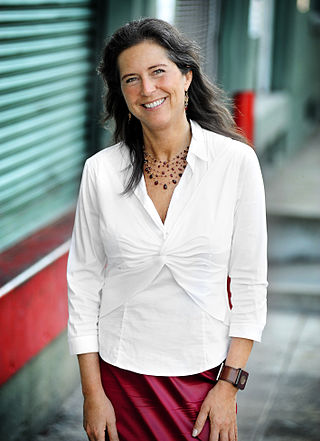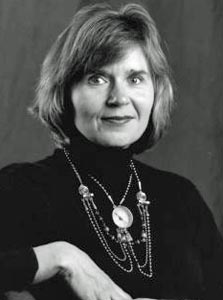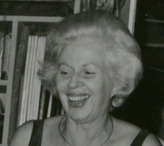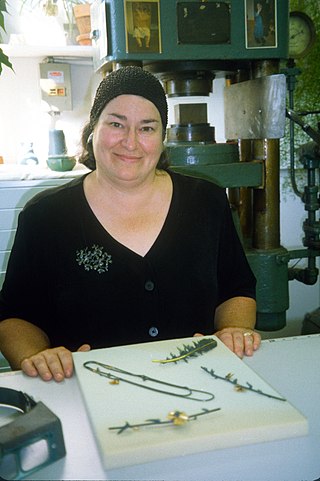Chunghi Choo is a jewelry designer and metalsmith who was born in Incheon, Korea in 1938. She received a BFA degree from Ewha Womans University in Seoul, Korea, where she majored in Oriental painting and studied philosophy of Oriental art and Chinese brush calligraphy. She moved to the United States in 1961 to study metalsmithing, weaving, and ceramics at Cranbrook Academy of Art in Bloomfield Hills, Michigan, where she received an MFA in 1965.

Mary Lee Hu is an American artist, goldsmith, and college level educator known for using textile techniques to create intricate woven wire jewelry.
Linda MacNeil is an American abstract artist, sculptor, and jeweler. She works with glass and metal specializing in contemporary jewelry that combines metalwork with glass to create wearable sculpture. Her focus since 1975 has been sculptural objets d’art and jewelry, and she works in series. MacNeil’s jewelry is considered wearable sculpture and has been her main focus since 1996.

Ivy Ross is an American business executive, jewelry designer, and, since July 2016, vice president of hardware design at Google. She has worked at Google since May 2014; prior to being appointed VP of hardware design, she led the Google Glass team at Google X. Ross's metal work in jewelry design is in the permanent collections of 12 international museums, including the Smithsonian in Washington D.C. One of few recognized fine artists to successfully cross over into the business world, Ross is also a keynote speaker and a member of several boards, and has been hailed as a “creative visionary” by the art world. In February 2019 she was named one of the 15 Most Powerful Women at Google by Business Insider. In July 2019 she was named #9 on Fast Company's 100 Most Creative People in Business. Ivy is the co-author of the New York Times bestselling book Your Brain on Art: How the Arts Transform Us with Susan Huganir Magsamen. This book shares the science behind humanities birthright - to make and behold art and its power to amplify physical and mental health, learning and build stronger communities.

Nancy Lee Worden was an American artist and metalsmith. Her jewelry art is known for weaving together personal narratives with current politics. She received many awards and honors. Worden exhibited internationally, and her work is represented in collections around the world, including the Smithsonian American Art Museum and the Museum of Fine Arts, Boston.

Lisa Gralnick is an American contemporary metalsmith, studio jeweler and academic. She works in the field of craft and art jewelry. Gralnick says: "I have chosen to make jewelry, which is traditionally considered 'craft', and I do enjoy the processes and techniques that allow me to execute my work without technical faults. But 'craft' is only a means to an end for me, as it is for many artists. My desire to push the limits of jewelry and expand on them, to comment on its traditions and associations, is more the concern of any artist."

Catherine Elizabeth Cooke was an American designer principally known for her jewelry. She has been called "an icon within the tradition of modernist jewelry" and "a seminal figure in American Modernist studio jewelry". Her pieces have been shown nationally and internationally and are included in a number of museum collections, including the Museum of Modern Art (MOMA) in New York. She is regarded as an important role model for other artists and craftspeople.
Susie Ganch is a first generation American artist of Hungarian heritage. She is a sculptor, jeweler, educator, and founder and director of Radical Jewelry Makeover. Ganch received her Bachelors in Science from the University of Wisconsin-Madison in Geology in 1994 and her Masters in Fine Arts from the University of Wisconsin-Madison in 1997.
Lauren Kalman is a contemporary American visual artist who uses photography, sculpture, jewelry, craft objects, performance, and installation. Kalman's works investigate ideas of beauty, body image, and consumer culture. Kalman has taught at institutions including Brown University and the Rhode Island School of Design. Currently she is an associate professor at Wayne State University.
Myra Mimlitsch-Gray is an American metalsmith, artist, critic, and educator living and working in Stone Ridge, New York. Mimlitsch-Gray's work has been shown nationally at such venues as the John Michael Kohler Arts Center, Museum of the City of New York, Metropolitan Museum of Art, Cooper-Hewitt Smithsonian Design Museum, and Museum of Arts and Design. Her work has shown internationally at such venues as the Middlesbrough Institute of Modern Art, Stadtisches Museum Gottingen, and the Victoria and Albert Museum, and is held in public and private collections in the U.S, Europe, and Asia.

Florence Lisa Resnikoff was an American artist and educator in the fields of metals and jewelry.

Alma Rosalie Eikerman was an American metalsmith, silversmith, and jewelry designer who was instrumental in building the metals program at Indiana University, of which she retired Distinguished Professor Emeritus. She was a founding member of the Society of North American Goldsmiths and studied under several internationally renowned metalsmiths, such as Karl Gustav Hansen. Eikerman's work has appeared in over 200 exhibitions, including Objects: USA at the Smithsonian Institution.
Linda Threadgill is an American artist whose primary emphasis is metalsmithing. Her metal work is inspired by forms of nature and the interpretations she gleans from the intricate patterns it presents. She explores the foundation of nature to allude to nature and transform it into re-imagined, stylized plants forms.

Marjorie Schick was an innovative American jewelry artist and academic who taught art for 50 years. Approaching sculptural creations, her avant-garde pieces have been widely collected. Her works form part of the permanent collections of many of the world's leading art museums, including the Hermitage Museum in Saint Petersburg, Russia; the Museum of Arts and Design in New York City; the National Museum of Modern Art in Kyoto, Japan; the Philadelphia Museum of Art in Pennsylvania; and the Victoria and Albert Museum of London.

Jan Yager is an American artist who makes mixed media jewelry. She draws inspiration from both the natural world and the lived-in human environment of her neighborhood in Philadelphia, Pennsylvania, emphasizing that art is a reflection of both time and place. She has incorporated rocks, bullet casings, and crack cocaine vials into her works, and finds beauty in the resilience of urban plants that some would consider weeds.
Adda "Andy" Thyra Elise Louise Husted-Andersen was a Danish-born American Modernist jeweler, silversmith, metalsmith, and educator. She was a co-founder and the president of the New York Society of Craftsmen from 1941 to 1944. She was a master of working with enamel, silver and gold. She was active in New York City and Copenhagen.

Merry Renk, also known as Merry Renk-Curtis, was an American jewelry designer, metalsmith, sculptor and painter. In 1951, she helped to found the Metal Arts Guild (MAG), and served as its president in 1954.
Hiroko Sato-Pijanowski is a Japanese jewelry designer, artist, author and educator. Sato-Pijanowski is credited with introducing Japanese materials and techniques to American metal working. She is based in Yokohama in Kantō, Japan.
Glenda Arentzen is an American jeweler, goldsmith, and educator. In 2008, Arentzen was elected a Fellow of the American Craft Council (ACC).
Marilyn da Silva is an American sculptor, metalsmith, jeweler, and educator. She teaches and serves as a department head at the California College of the Arts in the San Francisco Bay Area. Da Silva has won numerous awards including honorary fellow by the American Craft Council (2007).










